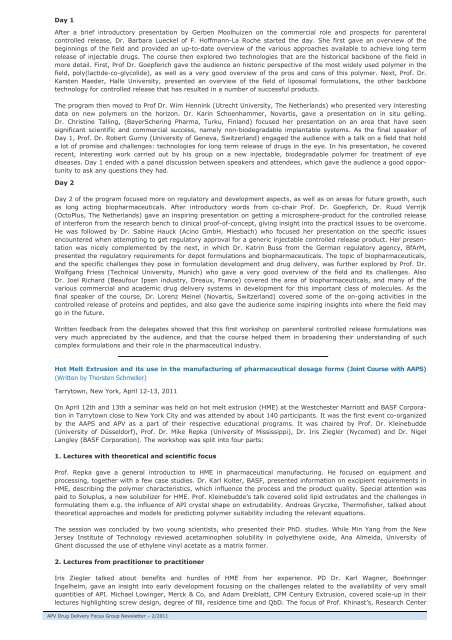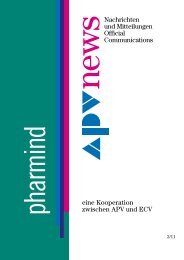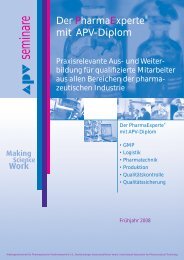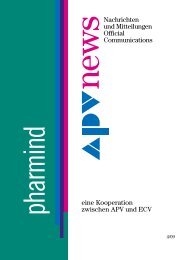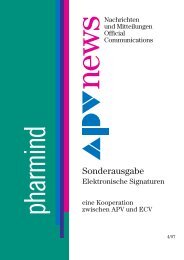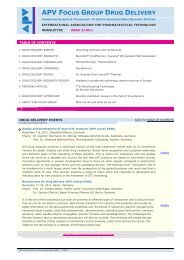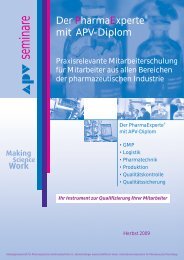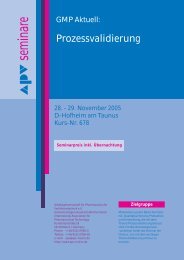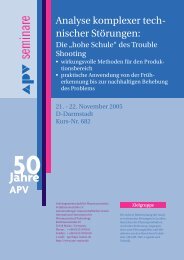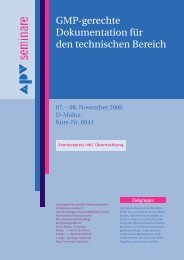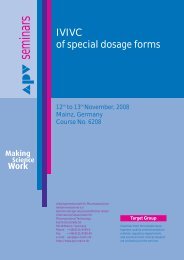APV FOCUS GROUP DRUG DELIVERY
APV FOCUS GROUP DRUG DELIVERY
APV FOCUS GROUP DRUG DELIVERY
Create successful ePaper yourself
Turn your PDF publications into a flip-book with our unique Google optimized e-Paper software.
Day 1<br />
After a brief introductory presentation by Gerben Moolhuizen on the commercial role and prospects for parenteral<br />
controlled release, Dr. Barbara Lueckel of F. Hoffmann-La Roche started the day. She first gave an overview of the<br />
beginnings of the field and provided an up-to-date overview of the various approaches available to achieve long term<br />
release of injectable drugs. The course then explored two technologies that are the historical backbone of the field in<br />
more detail. First, Prof Dr. Goepferich gave the audience an historic perspective of the most widely used polymer in the<br />
field, poly(lactide-co-glycolide), as well as a very good overview of the pros and cons of this polymer. Next, Prof. Dr.<br />
Karsten Maeder, Halle University, presented an overview of the field of liposomal formulations, the other backbone<br />
technology for controlled release that has resulted in a number of successful products.<br />
The program then moved to Prof Dr. Wim Hennink (Utrecht University, The Netherlands) who presented very interesting<br />
data on new polymers on the horizon. Dr. Karin Schoenhammer, Novartis, gave a presentation on in situ gelling.<br />
Dr. Christine Talling, (BayerSchering Pharma, Turku, Finland) focused her presentation on an area that have seen<br />
significant scientific and commercial success, namely non-biodegradable implantable systems. As the final speaker of<br />
Day 1, Prof. Dr. Robert Gurny (University of Geneva, Switzerland) engaged the audience with a talk on a field that hold<br />
a lot of promise and challenges: technologies for long term release of drugs in the eye. In his presentation, he covered<br />
recent, interesting work carried out by his group on a new injectable, biodegradable polymer for treatment of eye<br />
diseases. Day 1 ended with a panel discussion between speakers and attendees, which gave the audience a good opportunity<br />
to ask any questions they had.<br />
Day 2<br />
Day 2 of the program focused more on regulatory and development aspects, as well as on areas for future growth, such<br />
as long acting biopharmaceuticals. After introductory words from co-chair Prof. Dr. Goepferich, Dr. Ruud Verrijk<br />
(OctoPlus, The Netherlands) gave an inspiring presentation on getting a microsphere-product for the controlled release<br />
of interferon from the research bench to clinical proof-of-concept, giving insight into the practical issues to be overcome.<br />
He was followed by Dr. Sabine Hauck (Acino GmbH, Miesbach) who focused her presentation on the specific issues<br />
encountered when attempting to get regulatory approval for a generic injectable controlled release product. Her presentation<br />
was nicely complemented by the next, in which Dr. Katrin Buss from the German regulatory agency, BfArM,<br />
presented the regulatory requirements for depot formulations and biopharmaceuticals. The topic of biopharmaceuticals,<br />
and the specific challenges they pose in formulation development and drug delivery, was further explored by Prof. Dr.<br />
Wolfgang Friess (Technical University, Munich) who gave a very good overview of the field and its challenges. Also<br />
Dr. Joel Richard (Beaufour Ipsen industry, Dreaux, France) covered the area of biopharmaceuticals, and many of the<br />
various commercial and academic drug delivery systems in development for this important class of molecules. As the<br />
final speaker of the course, Dr. Lorenz Meinel (Novartis, Switzerland) covered some of the on-going activities in the<br />
controlled release of proteins and peptides, and also gave the audience some inspiring insights into where the field may<br />
go in the future.<br />
Written feedback from the delegates showed that this first workshop on parenteral controlled release formulations was<br />
very much appreciated by the audience, and that the course helped them in broadening their understanding of such<br />
complex formulations and their role in the pharmaceutical industry.<br />
Hot Melt Extrusion and its use in the manufacturing of pharmaceutical dosage forms (Joint Course with AAPS)<br />
(Written by Thorsten Schmeller)<br />
Tarrytown, New York, April 12-13, 2011<br />
On April 12th and 13th a seminar was held on hot melt extrusion (HME) at the Westchester Marriott and BASF Corporation<br />
in Tarrytown close to New York City and was attended by about 140 participants. It was the first event co-organized<br />
by the AAPS and <strong>APV</strong> as a part of their respective educational programs. It was chaired by Prof. Dr. Kleinebudde<br />
(University of Düsseldorf), Prof. Dr. Mike Repka (University of Mississippi), Dr. Iris Ziegler (Nycomed) and Dr. Nigel<br />
Langley (BASF Corporation). The workshop was split into four parts:<br />
1. Lectures with theoretical and scientific focus<br />
Prof. Repka gave a general introduction to HME in pharmaceutical manufacturing. He focused on equipment and<br />
processing, together with a few case studies. Dr. Karl Kolter, BASF, presented information on excipient requirements in<br />
HME, describing the polymer characteristics, which influence the process and the product quality. Special attention was<br />
paid to Soluplus, a new solubilizer for HME. Prof. Kleinebudde’s talk covered solid lipid extrudates and the challenges in<br />
formulating them e.g. the influence of API crystal shape on extrudability. Andreas Gryczke, Thermofisher, talked about<br />
theoretical approaches and models for predicting polymer suitability including the relevant equations.<br />
The session was concluded by two young scientists, who presented their PhD. studies. While Min Yang from the New<br />
Jersey Institute of Technology reviewed acetaminophen solubility in polyethylene oxide, Ana Almeida, University of<br />
Ghent discussed the use of ethylene vinyl acetate as a matrix former.<br />
2. Lectures from practitioner to practitioner<br />
Iris Ziegler talked about benefits and hurdles of HME from her experience. PD Dr. Karl Wagner, Boehringer<br />
Ingelheim, gave an insight into early development focusing on the challenges related to the availability of very small<br />
quantities of API. Michael Lowinger, Merck & Co, and Adam Dreiblatt, CPM Century Extrusion, covered scale-up in their<br />
lectures highlighting screw design, degree of fill, residence time and QbD. The focus of Prof. Khinast’s, Research Center<br />
<strong>APV</strong> Drug Delivery Focus Group Newsletter – 2/2011 Page 2 of 15


